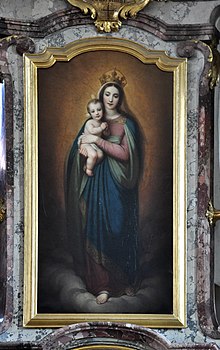Joseph Anton von Gegenbaur

Joseph Anton von Gegenbaur (born March 6, 1800 in Wangen im Allgäu , † January 31, 1876 in Rome ) was a German painter.
Life

Gegenbaur studied at the Academy of Fine Arts in Munich from 1815 to 1823 under Robert von Langer . During this time he created the motifs “Saint Sebastian” and “Two Shepherds” based on the example of Geßner's idylls as an altarpiece for the church in his home town of Wangen im Allgäu . From 1823 to 1826 and from 1829 to 1835 he continued his studies in Rome. There he distinguished himself primarily in color painting . In the residential palace in Stuttgart he later painted the works “Parents after the loss of paradise” and “Moses, knocking water out of the rock” using this technique.
After his return from Italy he was commissioned by King Wilhelm I of Württemberg to decorate the newly built Rosenstein Castle in Stuttgart with frescoes together with Gottlob Johann Gutekunst . He took the motifs from mythology .
When Gegenbaur was appointed court painter in 1835 , he was already well known in the Kingdom of Württemberg . In the years 1836 to 1854 he painted five halls on the ground floor and the first floor of the residential palace in Stuttgart with frescoes from the history of Württemberg. These pictures, which showed scenes with the Württemberg Counts Eberhard the Greiner , Eberhard the Illustrious , Ulrich the Beloved and Eberhard im Bart , were badly damaged in the bombing of the castle in World War II and destroyed after the war. However, photographs of it have been preserved. In 1864 Gegenbaur furnished the enlarged dining room of Friedrichshafen Palace with seven "allegorical pictures", which have also no longer been preserved.
His most famous oil paintings were in the possession of the kings of Württemberg, such as a sleeping Venus and two satyrs, a Leda, and several small Venus pictures. In the parish church of Wangen im Allgäu he created a large altarpiece "Madonna with the Child" . In addition, Gegenbaur also painted portraits and battle pictures . Although he was well known during his lifetime, he was forgotten after the end of the monarchy. Due to the destruction of his once very popular works and the long unpopularity of historicism , an appropriate appreciation has remained until today.
In 1844 Gegenbaur was awarded the Knight's Cross of the Order of the Württemberg Crown , which was associated with the personal title of nobility.
Joseph Anton von Gegenbaur died in Rome at the age of 76 and was buried on the Camposanto Teutonico .
Memorial and honors
The Munich sculptor August Schädler created a monument to the painter in 1901 for Gegenbaur's hometown of Wangen . In Wangen, the Anton von Gegenbaur school and Gegenbaurstrasse (next to his monument) were named after Gegenbaur.
literature
- August Wintterlin: Gegenbauer, Josef Anton . In: Allgemeine Deutsche Biographie (ADB). Volume 8, Duncker & Humblot, Leipzig 1878, pp. 495-497.
- Andreas Stolzenburg: Joseph Anton von Gegenbaur (1800–1876). To the royal Württemberg court painter on his 200th birthday . Exhibition catalog. Wangen im Allgäu 2000.
Web links
- Literature by and about Joseph Anton von Gegenbaur in the catalog of the German National Library
Individual evidence
- ^ Court and State Handbook of the Kingdom of Württemberg. 1866, p. 40
| personal data | |
|---|---|
| SURNAME | Gegenbaur, Joseph Anton von |
| ALTERNATIVE NAMES | Gegenbaur, Anton von |
| BRIEF DESCRIPTION | German painter |
| DATE OF BIRTH | March 6, 1800 |
| PLACE OF BIRTH | Wangen in the Allgäu |
| DATE OF DEATH | January 31, 1876 |
| Place of death | Rome |
